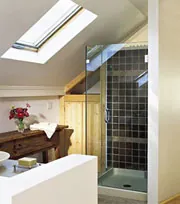Home decorating is typically an on-going endeavor striving for perfection without knowing exactly what that entails.
After spending hours upon hours debating paint colors, floor layouts, fabrics, and accessories, you feel as if some progress has finally been made. However, how much attention have you given to your lighting? You can have wonderful tones, materials, and layouts chosen, but without adequate lighting they may not be fully appreciated. To combat this situation, many people invest in decorative lamps, floor stands, recessed lighting, or large fixtures that fill a ceiling. While all excellent options, skylights are becoming the standard for new homes desiring well-lit expanses that enhance clean lines and minimalist concepts. Skylights add warmth and scope while conveniently remaining out of the way.
Installing skylights is best left to a professional as there are some architectural components that will need to be addressed. The first of these is awareness of beams, ductwork, or service lines that are located where you desire a skylight. Secondly, the skylight's size cannot overpower the room. Depending on the number of other windows in the room, the skylight should be no greater than 5-15% of the floor area. Additionally, the light brought into the home by a skylight depends on the direction in which that particular section of the roof faces.
-
North: fairly constant yet cool sunshine
-
East: maximum position for morning light and solar heat gain
-
West: ideal for afternoon sunlight and solar heat gain
-
South: provides desirable solar heat gain in the cold seasons, but can be overbearing in the warm summer
The placement of your skylight will be a large determinant in what material and shape your skylight will consist of. When choosing a material, acrylic and glass glazing are both quite popular.
Acrylic (Plastic)
-
Inexpensive option
-
Less vulnerable to breaking on impact
-
Can scratch easily
-
May become brittle or discolored
-
Allows most UV rays in, increasing risk of fading damage to textiles/walls (this can be combated with special treatments/tinting that will block UV rays)
Glass
-
More expensive than acrylic
-
Not as impact resistant as acrylic, but choices of tempered or laminated glass prevent glass from breaking into shards. Instead, the material will shatter upon intense impact, easing risk of injury.
-
Durable towards scratching and discoloration
-
Superior energy efficiency
-
Roof must have a specific rise to accommodate skylight; flatter roofs may have to make adjustments.
Both acrylic and glass skylights can be installed in fixed or ventable models. Ventable models can be set to open outward at the bottom either manually or by an electric motor activated via a switch or remote. Moisture sensors can be installed as well, allowing skylights to close automatically at the first few drops of a rain shower. Ventable skylights are slightly more expensive, but access to fresh air along with the sunlight is well worth a small surcharge. Heat absorbing tints, extra insulating glazes, and mini blinds or roller shades are add-ons that may improve the functionality of your skylights for a nominal fee.
 |
©solutionsathand.com |
The shape of your skylight is dependent on personal preference as they come rectangular, circular, oval, diamond, triangular, multi-sided and tubular. The glazing (glass or acrylic) can be flat, arched, domed, or pyramidal. Certain contractors and homes may not be compatible with all combinations, so speaking to multiple professionals is best. Seeking recommendations from homeowners whose skylights have withstood at least five rainy seasons is also advised. This time span is considered long enough to determine if the material and installation are truly of good quality. Inquire about issues they may have had with the product over the past few years and whether or not they would recommend the specific product or professional. Becoming a well-informed consumer is far superior to finding yourself with leaking skylights throughout your home.
There are some circumstances that require special precautions when installing a skylight, such as those installed higher than 10 feet above the ground are required to be laminate. Though laminate may shatter upon impact, the window will not fall free, thus reducing the chance of injury. In snow-inclined regions, skylights require a special glaze designed to withstand specific snow and ice loads. In addition to speaking with professionals, it is necessary to check local building codes and energy codes to be certain your home will meet the requirements. By following these few steps in preparation, incredible lighting can be one more accomplishment in your home decorating.
Here are some related articles:
View Other Related House Plans:
Save this article to:
back to top